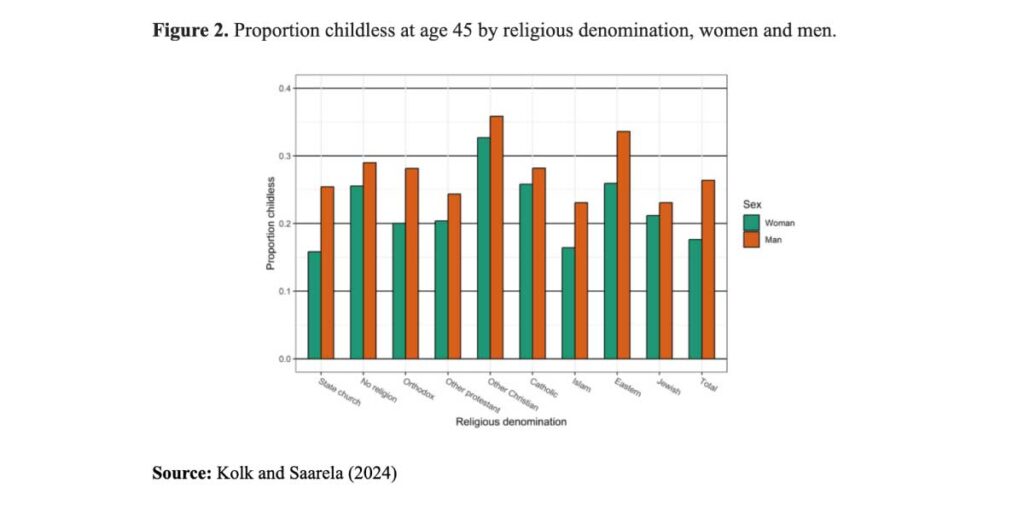The link between religion and fertility has long interested demographers. While relevant data with the necessary extent and detail are rarely available, Finland, is an exception, as information on religious affiliation is recorded in its population registers. However, as Martin Kolk and Jan Saarela find out, fertility differences across religious groups in Finland turn out to be relatively minor.
We recently examined the connection between religion and fertility in Finland (Kolk and Saarela, 2024). Our study differs from most previous literature in that we use national register data on religious denominations. Finland, in contrast to nearly all other countries in the world, includes religion in its longitudinal registers.
The influence of religion on fertility
The link between religion and fertility is a classical topic in demographic research, as discussed for instance by Notestein (1945) when he introduced his theory of the demographic transition. It was also an important explanatory factor in the quest to explain the European fertility decline in the 19th century (e.g. Lesthaeghe 1983).
We investigated several dimensions of the phenomenon that had previously being overlooked, or considered only superficially, in the demography of religion, such as differences across converts, and the influence of religious homo/heterogamy. In contrast to much previous research, we did not focus on religiosity (practices and beliefs) but considered only differences by denomination. This, we admit, is a potential limitation of our research: it is one thing to belong formally to a given religious group, but another to actually share that specific worldview, follow certain precepts, etc.
The Finnish religious landscape
The Finnish religious landscape is dominated by a large Lutheran state church, a growing number of unaffiliated churches, and a smaller official orthodox state church (related to former Russian rule). Other denominations are rather small. The quite distinct Laestadian community is (for now) integrated into the state church. However, our religious data are very detailed, and we can show our results for all the main religious groups. Our study is based on all women and men born between 1956 to 1975 who were resident in Finland from age 15 up to at least age 45. Most of the recent immigrants to Finland are therefore, and regretfully, excluded from the analysis.
Religion does not matter much, after all – not in Finland, at least
Overall, our most important finding is that differences in fertility across denominations in Finland are quite small (Figure 1). We find the lowest childbearing among the unaffiliated, and, interestingly, typically find higher fertility among members of the State Church than other denominations.

The largest differences relate to childlessness (Figure 2), where we find particularly elevated levels of childlessness among non-affiliated women. We also find higher childlessness among “other Christians” (mostly Jehovah’s Witnesses) and Eastern religions.
Some religious groups are rather small and should be understood in their distinct and unique national context. For example, Finnish Muslims in our study largely consist of Muslim tartars who arrived in Finland during Russian rule in the 19th century. In other words, the Finnish socioreligious context is peculiar (like most others, in fact, but each in its own way), which should caution against hasty extrapolations of our results to other countries.
Several other dimensions of fertility and religion could be considered, such as differences between endogamous and exogamous unions across denominations, or between converts and non-converts, and this is done in our scientific paper (Kolk and Saarela 2024). Results cannot be reported here, for reasons of space, but interested readers are welcome to read our (open access) publication.
References
Kolk, M & Saarela, J. (2024) Religion and Fertility: A Longitudinal Register Study Examining Differences by Sex, Parity, Partner’s Religion, and Religious Conversion in Finland. European Journal of Population, 40(3), 1-25. https://doi.org/10.1007/s10680-023-09693-0 (open access)
Lesthaeghe, R. (1983). A century of demographic and cultural change in Western Europe: An exploration of underlying dimensions. Population and Development Review, 9(3), 411–435.
Notestein, F. W. (1945). Population—The long view. In T. W. Schultz (Ed.), Food for the world. University of Chicago Press.



